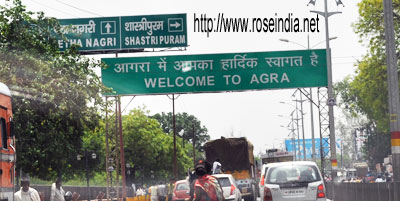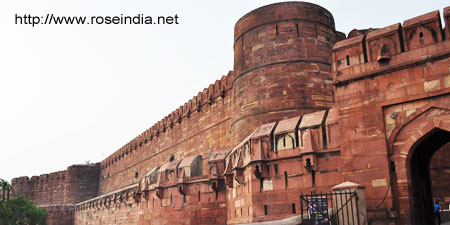Agra is the most popular heritage destination in India's travel map because of worldwide acclaimed Mughal monument Taj Mahal and other great architectures. For a traveler with tight itinerary and busy schedule Delhi to Agra single day trip can be ideal to cover the most important heritage monuments of Agra including Taj Mahal.
Ads
TutorialsAgra, the former capital of Mughal India has the crowning jewel of India’s heritage destinations, the glorious white mausoleum of Taj Mahal, one of the most beautiful historic monuments of the world. Every year millions of tourists from all parts of the planet flock to Agra primarily to experience the ravishing beauty of this superb monument. Beside Taj Mahal this royal city at the banks of Jamuna River offers other great architectural marvels of Mughal era including Akbars’s Tomb, Jama Masjid, Agra Fort and many other historical attractions spread throughout this old city. Agra is just 200 kilometers from Delhi and takes only 4 hours of drive in favorable traffic condition. Delhi to Agra single day trip and back to Delhi is a popular tour option offered by an array of tour operators.

The journey ADS_TO_REPLACE_1
It is better to start early in the morning so that you can reach early in the day time and can extend your Taj Mahal experience and visit famous heritage spots for most part of the day. This is really going to be a lifetime tour with 3 world famous heritage sites waiting at the end of the journey. So, start early in the morning, preferably at 7am and if there is no exceptional traffic hazards waiting on your way you will comfortably reach Agra around 11 in the morning. Stretch yourself a bit, have little snacks and get ready for the once-in-a-lifetime experience of seeing Taj Mahal in full glow under the midday sun.
Time to visit
Autumn to early winter or Spring time is the best season of the year to visit Agra. Summer is too hot for this part of the globe and winter is too foggy for your eyes to explore the marvels in broad daylight, though every time of the year the ravishing white mausoleum of Taj Mahal offers different specters and all have their own charms. The beauty of Taj Mahal slowly unfolding itself breaking apart the thick cover of winter fog is as much a rare specter as when the white stones of Taj shine in golden hue of summer afternoon.ADS_TO_REPLACE_2
Agra Heritages to cover
There is no dearth of heritage monuments and historically important monuments and architectures in this part of the world. For more than 500 years this royal city has been into hands of too many kings and dynasties including both the Muslim and Hindu ancestry until it became the capital of Mughal India. Naturally a single day trip is not enough to cover all the great heritage monuments of this royal city. You have no option but to cut your list to the most important and famous ones. It is needless to say that Taj Mahal would top the list and deserve most part of your time in Agra. Agra Fort and Akbar’s tomb are other two must visit monuments that your single day Delhi to Agra trip just cannot afford to miss.
Agra history and timelineADS_TO_REPLACE_3
Before you begin to explore the stupendous architectural marvels of this great city, a brief introduction to its rich historical lineage and the timeline of historical occurrences is important. Though for the rest of the world Agra is known as the erstwhile Mughal capital for its world famous white stone mausoleum of Taj Mahal, this north Indian city was in the crust of royal warfare and power struggles centuries before Mughals invaded India. Even in ancient epic like Mahabharata we have the reference to this wealthy city. The modern recorded history of Agra began from 11th century and until the beginning of sixteenth century this city changed hands of great many rulers, from both Muslim and Hindu ancestry. Sultan Sikandar Lodi moved his capital from Delhi to Agra in the year 1506 and when he was defeated by first Mughal ruler Babur in 1526 Agra became the capital of Mughal India. Since then the status of Agra as the capital of Mughal Empire remained almost uninterrupted and continuous except for a brief period when Sher Shah Suri would overthrow Mughals and reign for a brief period until the dynasty would be reclaimed by Mughals in 1556. Most of the great mausoleums, monuments and architectural wonders that gave Agra its worldwide fame are made by Mughals. From the dizzying heights of Mughal genius of architecture displayed throughout this city, you can conclude the history of this city is predominantly Mughal in character, at least on account of its heritage monuments.

Taj Mahal ADS_TO_REPLACE_4
This universally acclaimed and admired world heritage is the single most important monument that makes tourists, researchers, photographers and enthusiasts from all over the world flock to Agra. It is the crowning jewel of India’s heritage landscape. This gigantic white stone mausoleum was built by Mughal emperor Shah Jahan in the memory of his beloved wife Mumtaz. For centuries this iconic symbol of love has been the subject of wonder and scholarly enthusiasm. It is also the most visited monument in India. This UNESCO world heritage site is surrounded by sprawling Mughal gardens and offers a variety of breathtaking specters from any part of the city. The architecture with its four minars and huge dome in the center is awe inspiring for the eyes. Once you are fully taken over by the apparent beauty of this stupendous architecture it is time to go inside to explore the artworks it its interior. From the reflective tiles to the artistic inscriptions from the scripture, from the artworks in the Mumtaz Mahal to the delicate artworks in the Jali surrounding the cenotaphs, from the beautifully colored finial floor tiling work to the artistic inlay work everywhere – this is the treasure house of finest artworks representing the entire Mughal heritage in all its beauty and poetics.
Even a full day amounts to nothing when you feel yourself spellbound at the breathtaking view of Taj Mahal. But as your tour itinerary is just limited to a single day trip to the city you should plan your trip so that you can at least cover 3 main monuments within the main city of Agra. Exploring the interior and for making a 360 degree trip around the monument it may take a little more than 3 hours, even considering the breaks. Suddenly the time is up and you have to move on to the next heritage destination in your Agra tour itinerary.
Akbar’s Tomb ADS_TO_REPLACE_5
This is the first of its kind tomb in India built by the great Mughal Emperor Akbar. This act of building one’s tomb during the lifetime is taken from the ancient Tartary tradition. Though Akbar himself planned the construction of the tomb during his lifetime it was completed by his son Emperor Jahangir after the death of his father. Beside Taj Mahal it is one of the most visited Mughal monuments of Agra that attracts thousands of travelers from all parts of the planet. The tomb is located a little away from the main city, at Sikandra, a suburb location of Agra city. All dominant signs of Mughal architecture are in full display at the tomb with arched gateway, dome, interior jali works and minars. Mughals would always be remembered as great builders for their passion for elaborate and artistic architectures and this huge tomb is one such example. The gate at the south facing side is the largest that offers a specter of white marble minarets at both sides. This red sandstone monument is truly awe inspiring when the delicate inlay works and jali artworks in the interior are revealed to your eyes. From outside it may not be as impressive as the Taj Mahal but interior works represent the finest Mughal art and for that reason alone it deserves a visit.

Agra Fort ADS_TO_REPLACE_6
This massive red sandstone architecture sprawling over several kilometers is best described as a walled city. It is the second most important heritage destination after Taj Mahal and a UNESCO World Heritage Site. It is also the second most visited Agra monument after Taj Mahal. A smaller fort had been there at the spot since the 11th century until Mughal took over it gave it the present shape and elegance. Everything characteristically royal and Mughal are in full display throughout this stupendous walled architecture that withstood centuries of Mughal rule in all its glory, bloodshed and defeat. The walled architecture that covers a sprawling 94 acres of land is full of famous Mughal era architectures and monuments including Diwan-i-Aam, Diwan-i-Khas, Jahangir Palace and several notable palaces representing confluence of several architectural and artistic traditions. The fort has four gates in its four sides among which Delhi gate is the most impressive one and was built during Akbar’s rule. During the rule of Akbar several monuments representing diverse architectural traditions were built within the fort enclosure. Marble inlay work, artistic ceilings, detailed jali works are everywhere as in other famous Mughal monuments. After entering this gigantic palatial walled fort you will find your time running faster than ever before as you try to shed your eyes on all there is to see.
Advertisements